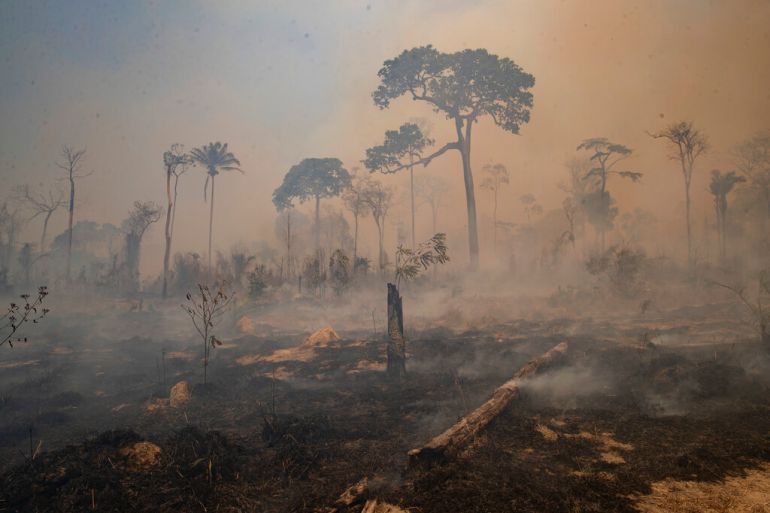Deforestation spurs wave of fires in Brazilian Amazon
Agribusiness interests push record deforestation, contributing to fire activity that has not been seen in years.

The Brazilian Amazon rainforest is suffering from more fires than at any point in nearly five years, spurred on by a surge in illegal deforestation.
According to Brazil’s national space institute, satellites have detected more than 33,000 fires as the rainforest enters the peak of fire season, which often correlates with high levels of deforestation activity.
Keep reading
list of 3 itemsBelongings of missing Indigenous expert, reporter found in Amazon
Brazilian prosecutors charge three suspects in Amazon murders
“The deforestation rate is very high. That means there are many fallen trees ready to burn,” Ane Alencar, coordinator of the Mapbiomas Fire project, told The Associated Press. “The fire season will be even more intense in September.”
Brazil’s far-right President Jair Bolsonaro has been criticised for his failure to combat illegal deforestation and for what critics have alleged is a sympathetic view of such activities. The fires are commonly started by groups making room for cattle to graze, and environmental land defenders and Indigenous groups have faced violence and suppression.
The Amazon experienced the worst August for fire in 12 years, but Bolsonaro has played down the criticisms, pushing for commercial activity in the Amazon and suggesting the criticisms are part of an effort to undermine Brazil’s agribusiness sector.
“Brazil does not deserve to be attacked in this way,” said Bolsonaro, who is campaigning for reelection.
“None of those who are attacking us have the right. If they wanted a pretty forest to call their own, they should have preserved the ones in their countries,” he wrote on Twitter last month.
A recent report by the Igarape Institute, a Brazilian think-tank, found that authorities are doing little to curb deforestation in the Amazon.
The study analysed 302 environmental crime raids carried out by the federal police in the Amazon between 2016 and 2021, and only 2 percent targeted people illegally seizing undesignated public lands.
Fires started to spread rapidly in August following a period of uncommonly high rainfall early in the month, according to Alencar. The blazes have created clouds of acrid smoke that can hover over cities such as Manaus, the largest city in the Amazon region, for weeks at a time.
About 20 percent of the area that has burned in the Amazon this year was recently deforested. Some of it is in areas that are supposed to be protected but are targeted by land-grabbers, according to an analysis by the Center of Life Institute, a Brazilian non-profit, based on NASA’s Global Fire Emissions Database.
Deforesters were unleashed on Cristalino II State Park in Mato Grosso, for example, after a state court invalidated the area’s protected status. State prosecutors have appealed the decision, but in the last several weeks, flames have consumed nearly 40sq km (15sq miles) according to the Center of Life Institute.
Half of Brazil’s carbon pollution is the result of land conversion. As the Amazon burns, areas that once played an important role in absorbing carbon have instead started to release large quantities into the atmosphere.
The Bolsonaro government promised to put an end to illegal deforestation by 2028 at the COP26 climate summit, but forest loss has increased to a 15-year high during his tenure.
“If Brazil wants to reduce its carbon emissions, the number one thing to do is reduce deforestation,” Alencar said. “And the second is to reduce the use of fire.”